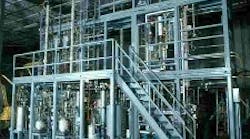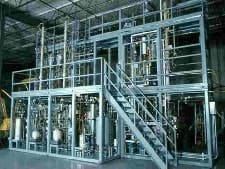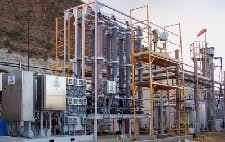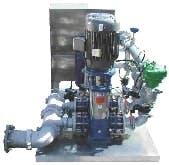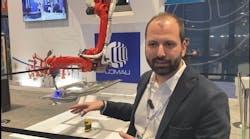We went looking for those positive benefits in the process skid-builder community. What we found paints a picture far more revealing of opportunity lost than of benefit gained.
Ian Drazin, electrical and instrumentation supervisor at Potlach Corp., a supplier of potash fertilizers in North Las Vegas, Nev., is very upset with the quality of his skid-built equipment. “My company recently purchased seven chemical skids and they’ve been nothing but a major problem,” he reports. “The problems include motor failures and pulsing positive displacement pump flows being measured by incorrectly specified flow transmitters. Where was the engineering? Did they ever field test their design?”Drazin also is unhappy that the equipment wasn’t built to spec. “None of our corporate electrical standards were followed,” he adds.So why buy skid-mounted equipment in the first place? “I have the expertise in my department to build any system I wish,” he says. “The problem is limited man-hours. We simply have too many other items on our plate that will directly affect machine run time if we don’t work on them first. There is not enough time left over to devote to building our own skid system. Therefore, we turn to third-party suppliers.”In addition, when these systems actually do their jobs, the equipment supplied often doesn’t meet the user’s desired configuration and standards. “My latest problem comes from two different vendors for automatic pH neutralization and polymer mixing and injection,” says Gary Jacobson, P.E., project manager at CH2M Hill, a Boston-based consulting engineering firm. “Our clients sometimes want the system to conform to their standard for PLCs or operator interfaces, and the skid vendors either refuse or do not provide what they have accepted an order for. Skid vendors have completely ignored comments to submitted drawings and documentation, or have agreed to incorporate comments, but then didn’t do so.”Other end users would only comment anonymously [see the “Angry Voices” sidebar below]. One reported, “I wouldn’t want to give the impression that we’re unable to manage the vendors. Although, in this case, I guess we can’t apparently, but neither can anyone else.”
This entire computer-controlled pilot plant for polymer research arrives at the customer site on a skid. Source: Unitel Technologies
Warren Searles, president of HydroTec Systems, a skid builder for waste and water treatment systems in Rockton, Ill., says problems often originate with the end user/owner, and a lack of communication from the owner to its vendors.“We provided a system involving several large pressure vessels, each fitted with a control harness of valves and sensors,” he explains. “The control is held together with an Allen-Bradley controller and network.” The entire system wasn’t coordinated as an entity, but rather was put together on site. The results were not pretty.“Once installed and started, the system does function, but not as desired by the owners, the operating management, and the operators,” explains Searles.How’s that again? “The system does meet the specification as written and enforced by the owners, therefore the project was signed off by the owner,” he explains. However, problems persist. The operator interfaces were designed for engineers, not operators, so the interfaces’ operator functions aren’t simple to understand. Also, engineering management is the first responder if problems occur, but if engineering management isn’t available, then the system must be shut off.Searles calls this project a “disjointed agglomeration,” and wishes he’d been allowed to build the system on a skid at his own shop. “The confusion is traceable to the owners,” he says. “The specification writers received their instructions from the owners. The writers understood the issues involved, but they were instructed to ignore the obvious, and produce a confusing spec. As the OEM, we ran into the same cacophony when we questioned items in the specification.”You may already have guessed it: Hydrotec’s project was for the U.S. government, considered by many to be the world’s worst communicator.However, miscommunication also happens with people who are supposedly competent communicators. For example, you'd think that engineering and procurement contractors (EPCs) would understand specifications and communicate them to the skid builders, but this is not necessarily so. One refinery control engineer, “Bob,” who requested anonymity, explains: “Our problems often come from engineering contractors we hire to manage projects and be our primary reps to third parties. When these contractors don’t insist that the skid builder meet our specs and standards, we’re going to have issues.”Contractors, EPCs Can Help
Michael Frey, sales engineer for skid builder Daniel Measurement & Control in Houston, says his company relies on engineering contractors to be their liaison with the end user. “As a metering-system-package supplier, Daniel interfaces with the EPCs for basic design requirements,” he explains. “These requirements are based on applying the metering system, destination of system, fluid measured, technology applied, industry standards, etc. It actually is the EPC’s responsibility to integrate the different skids to each other. As a skid supplier, it’s necessary for us to adhere strictly to specifications provided by EPC and end user. There is no room in our scope of supply for a ‘one size fits all’ and ‘take it or leave it’ stance.”Frey says EPCs are especially necessary these days. “The oil and gas companies no longer have the personnel to engineer, procure, fabricate, test and commission a metering system,” he says. “EPCs provide turnkey systems to oil/gas companies for specific projects. Several skid packages will be part of the project, and metering systems are one of those packages.” EPCs solicit bids for the various skids, select vendors, and then are responsible for integrating them, he says.
Some end users have ways to handle uncooperative skid builders. Eric Marcelo, control engineer in the coffee department of Nestle Phils, in Cagayan de Oro, Phillipines, believes it just takes a little extra effort. “For the most part, I haven't had a problem with skid builders,” says Marceleo. “Most of the skids are designed by our company, and skid builders build them to spec. These guys are the ones we've done business with for a long time, so they know how we work. This usually means they use the same PLCs we use, so communication is just a matter of laying out a cable and connecting it to the network.”Marcelo says he also buys standard systems. “We buy systems that are generic, but most of these are standalone, meaning they don't interface or interact with our systems.”Even so, communication problems still come up. “One manufacturer neglected to tell us they could build us a skid with the same type of PLC we usually use,” adds Marcelo. “So, these skids became standalone, when they easily could have been tied in with our system.”Being a big company also seems to help. “Our company has enough clout that we could threaten to blacklist a supplier that doesn't perform to our standards,” Marcelo notes, frankly. “This usually keeps them in line. However, close coordination still is the best way to ensure that everybody does what is expected of them.”“Bob,” the anonymous refinery control engineer, seems to have given up on getting skid vendors to meet his specs. “We’ve had some success by removing all the controls from the skid,” he says. “We have the vendor wire I/O to a junction box, so he’s not responsible for purchasing, installing, programming and documenting a control system. This lets all the I/O come to our DCS/PLC system, and puts the cost, engineering and installation on us. Most skid builders will do this before they’ll accept responsibility for programming an ‘alien’ DCS or PLC.”Lehigh adds MPT is happy to wire to a junction box at the user’s request. “Sometimes, end users don’t want outside contractors to access their DCS for proprietary reasons,” he explains. “In that case, we’ll provide everything at a wiring panel, and let the end user be responsible for interfacing to the DCS. We mostly use Allen-Bradley PLCs, so interfacing is not a problem for them.”End Users’ Needs
Though it may seem like many end users are being as obnoxious, unreasonable, and overly demanding as the builders they’re mad at, most users have genuine concerns about integrating skid systems into their plants. “Skid builders should be receptive to end user-stated standards and preferences, and recognize that these are desired for good reasons,” says Jacobson.Unitel’s Randhava adds, “Usually, three types of interfaces have to be taken into consideration. These include fluid interface, such as gases, liquids and solids; electrical interfaces; and computers and data connectivity. The correct specification of the wiring within the skid should always be of critical importance, especially if the end product will be shipped overseas. Electrical codes and explosion-proof requirements can vary significantly by country, and even in one nation, regional and local regulations can sometimes supersede national standards. In any event, rewiring in the field is always a nightmare.”
Skid systems such as this crude oil prover must be custom designed for each customer application. Source: Daniel Measurement & Control
How can users and skid builders get on the same page for electrical standards and good practices? Face-to-face discussions can help, and Jacobson has a few suggestions for end users:
- Insist on a face-to-face pre-design meeting and/or a face-to-face meeting to review comments to submittals.
- Recognize that customization is costly and expect to pay, not the lowest price, but the price that enables the skid builder to deliver the desired level of customization.
- Make sure the owner's desires or the manufacturer's needs, questions and costs are communicated to the skid builder, and don’t let general contractors prevent this from happening.
- Withhold payment until the system meets the specification. Write specifications that state a percentage of payment will be withheld until completion to ensure compliance.
Drazin agrees that having face-to-face meetings and withholding payments are useful. “The only way to hold skid builders accountable is to have discrepancies in standards affect their bottom line,” he says. “Incorporate a contractual penalty fee for not meeting specification into every contract, and then hold skid builders accountable to that contract.”
Mike, a project engineer at an EPC, offers these similar, common-sense suggestions to help skid builders work with end users:
- Face-to-face meetings between end-users and skid builders are needed, so both sides of the table understand one another. Don’t rely on an intermediary, like an EPC.
- Make it clear to both the EPC and the end-user if/when there are issues to which you take exception.
- Explain ahead of time why you can't or won't be able to meet an end user’s specs and standards. Tell the user, for example, if you don’t have in-house expertise to make desired changes, if it would significantly affect the schedule, or if it would be prohibitively expensive.
- Work with end users who have preferences. Learn why they have those preferences. This may hold the key to something that could be marketable.
“In the best way possible, demand that users tell you what you need to do, or leave you alone to deliver what you know is already an excellent product,” advises Mike. “Don’t be afraid to let the customer know that extra money and time will likely be involved to tweak your standard offering.”
Conforming to Open Standards
Control equipment vendors have another simple solution for end users and skid builders: “Use our open-architecture equipment,” they say, “and you can integrate everything easily.” Though somewhat self-serving, there’s truth in this suggestion because fieldbus architectures are increasingly, readily available. HART is built into just about every field instrumentation device, making it easy for a skid builder to obtain diagnostic and calibration information. By purchasing Device Description (DD) Services software from the HART Foundation and integrating it into a skid’s PC-based controller, the skid builder can provide a universal integration path to the skid’s instrumentation.
Basic End User Issues
HERE ARE some fundamental tasks skid builders need to address to collaborate successfully with end users.
- Maintenance: If the skid or package is going to be maintained by plant technicians, then end users usually prefer that equipment, such as instrumentation and controls, be similar to what is already being used in the plant. This minimizes training costs and keeps spare parts inventories low.
- Best Practices: Some users have developed installation and wiring standards based on long experience in their particular application or industry. They know what works and what causes problems. Therefore, they want skid builders to conform to these practices.
- Regulatory: Some plants must conform to rules and regulations from the FDA, EPA, OSHA and similar agencies. They want skid systems to conform to these rules, too. “Within our customer base we see an increasing demand for integration of skid-based systems, such as clean-in-place (CIP) and batch systems that are controlled by the DCS,” says Todd Stauffer, PCS 7 marketing manager at Siemens Energy & Automation. “We have one large customer in the brewing industry that insists on tightly integrating its CIP system into the main process control system. They report that this helps minimize the chance that a CIP cycle is missed, helps create consistent reporting, and eliminates the need for specialized training on the CIP system.”
- Integration: While some users treat skid systems as appliances, that is, a universal device that plugs in and does its job all by itself, many users want to integrate the skid system into an overall plant control scheme. If the skid is a closed system, then integration becomes much more difficult.
“Mike” and “Bob” Speak Out
THOUGH WE usually get more than enough on-the-record comments for articles, many end users simply couldn’t speak by name about their struggles with skid builders. So we decided to include “Mike” and “Bob’s” input because they seemed to have some especially sincere thoughts on these issues.
Bob, a control engineer at a major petroleum refinery, stated, “I’ve found that most skid vendors tend to ignore our detailed company specifications. They have a skid design that was proven in use and engineered with associated drawings, so any deviations are a major cost to them. Compatibility with our installed base of valves, pumps, electrical fittings, wire codes and junction boxes typically isn’t something that vendors worry about. Integration into existing PLC and DCS systems also causes issues, because skid vendors have a preferred system that might not be compatible with end user systems.”
Meanwhile, Mike, a project engineer at an engineering construction firm, adds, “Skid-mount and packaged systems have been, by far, the most problematic and bemoaned installations in the plants I’ve worked during the last 25 years. After several recent projects, we gathered engineers together to capture our dismay in a ‘lessons learned’ meeting. Our primary concern was with the engineering contractors who didn’t take seriously the requirement that all suppliers adhere to our standards. They knew that suppliers of skid-mounted systems would give us their standard offering. Not only did we have to deal with engineering contractor arrogance, it was frustrating to deal with the arrogance of third-party suppliers, who would refuse to meet our standards. Hey, when you got a niche in the market or are the market leader, you can sell the user whatever you want, right?”
Continue Reading

Leaders relevant to this article:
